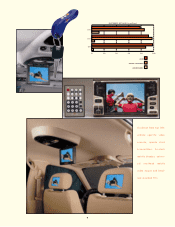Audiovox 1998 Annual Report Download - page 21
Download and view the complete annual report
Please find page 21 of the 1998 Audiovox annual report below. You can navigate through the pages in the report by either clicking on the pages listed below, or by using the keyword search tool below to find specific information within the annual report.
Liquidity and Capital Resources
The Company’s cash position at November 30, 1998 was
approximately $47 below the November 30, 1997 level.
Operating activities provided approximately $17,378, primar-
ily from decreases in inventory and increases in accounts
payable, accrued expenses and other current liabilities.
These events were partially offset by an increase in accounts
receivable and a decrease in income taxes payable. Investing
activities used approximately $9,197, primarily from the pur-
chases of investment securities and property, plant and
equipment, partially offset by the net proceeds from the sale
of investment securities. Financing activities used approxi-
mately $8,113, primarily from net repayments under line of
credit agreements and repurchase of Class A Common Stock
and warrants.
On February 9, 1996, the Company’s 10.8% Series AA and
11.0% Series BB Convertible Debentures matured. The
Company paid $4,362 to holders on that date. The remain-
ing $1,100 was converted into 206,046 shares of Common
Stock. On November 25, 1996, the Company concluded an
exchange of $41,252 of its 61⁄4% subordinated debentures
for 6,806,580 shares of the Company’s Class A Common
Stock. Accounting charges to earnings for this transaction
were $29,206, including income taxes on the gain of the
exchange of the bonds. As a result of the exchange, stock-
holders’ equity was increased by $34,426.
On October 1, 1996, business formally conducted by the
Company’s cellular division was continued in a newly-formed,
wholly-owned subsidiary called Audiovox Communications
Corp. Capitalization of this company was accomplished by
exchanging the assets of the former division, less their
respective liabilities, for all of the common stock.
On May 5, 1995, the Company entered into the Second
Amended and Restated Credit Agreement (the Credit
Agreement) which superseded the prior agreement in its
entirety. From its inception on May 5, 1995 through
November 30, 1998, the Credit Agreement was amended a
total of 13 times providing for various changes to the terms.
The terms as of November 30, 1998 are summarized below.
Under the Credit Agreement, the Company may obtain
credit through direct borrowings and/or letters of credit to a
maximum aggregate amount of $95,000. These borrowings
are subject to certain conditions with borrowings based on a
formula which takes into account the amount and quality of
the Company’s accounts receivable and inventory. The
obligations of the Company under the Credit Agreement
are guaranteed by certain of the Company’s subsidiaries
and are secured by accounts receivable of the Company
and those subsidiaries.
On December 23, 1998, the Company entered into the
Third Amended and Restated Credit Agreement (the
Revised Credit Agreement) which superseded the Second
Amended and Restated Credit Agreement in its entirety.
The major changes in the Revised Credit Agreement
included an increase in the maximum aggregate amount of
borrowings to $112,500 and allowed for a sub-limit for for-
eign currency borrowing of $15,000. The Revised Credit
Agreement contains covenants requiring, among other
things, minimum levels of pre-tax income and minimum lev-
els of net worth as follows: pre-tax income of not less than
$1,500 for the two consecutive fiscal quarters ending May 31,
1999, 2000 and 2001; not less than $2,500 for two consecu-
tive fiscal quarters ending November 30, 1999, 2000 and
2001; and not less than $4,000 for any fiscal year ending on or
after November 30, 1999. Further, the Company may not
incur a pre-tax loss in excess of $1,000 for any fiscal quarter
and may not incur a pre-tax loss for two consecutive fiscal
quarters. In addition, the Company must maintain a net worth
base amount of $172,500 at any time prior to February 28,
1999; $175,000 at any time on or after February 28, 1999 but
prior to February 28, 2000; $177,500 at any time on or after
February 28, 2000, but prior to February 28, 2001; and
$180,000 at any time thereafter. Further, the Company must
at all times maintain a debt to worth ratio of not more than
1.75 to 1. The Revised Credit Agreement includes restrictions
and limitations on payments of dividends, stock repurchases
and capital expenditures. The Revised Credit Agreement
expires on December 31, 2001.
The Company believes that it has sufficient liquidity to
satisfy its anticipated working capital and capital expendi-
ture needs through November 30, 1999 and for the reason-
able foreseeable future.
Impact of Inflation and Currency
Fluctuation
Inflation has not had and is not expected to have a signif-
icant impact on the Company’s financial position or operat-
ing results. However, as the Company expands its
operations into Latin America and the Pacific Rim, the
effects of inflation and currency fluctuations in those areas, if
any, could have growing significance to the financial condi-
tion and results of the operations of the Company.
The Company has operations and conducts local business
in Asia. The recent fluctuations in the foreign exchange rates
have not materially impacted the consolidated financial
position, results of operations or liquidity. Management
believes that continued fluctuations will not have a material
adverse effect on the Company’s consolidated financial
position, however the impact on the results of operations or
liquidity, particularly our Malaysian subsidiaries, is unknown.
While the prices that the Company pays for the products
purchased from its suppliers are principally denominated in
United States dollars, price negotiations depend in part on
the relationship between the foreign currency of the foreign
manufacturers and the United States dollar. This relationship
is dependent upon, among other things, market, trade and
political factors.
19
























